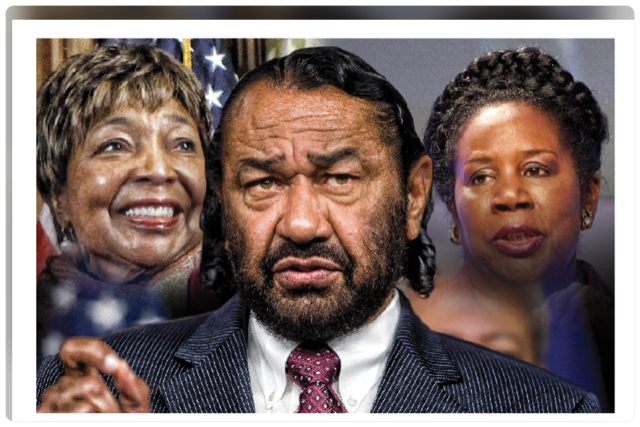By: Roy Douglas Malonson
Minority Democrats are fighting mad after Texas lawmakers recently released a draft of the new congressional map that threatens minority voters and their current leaders. Is it racism? Is it a ploy to protect Republicans under a loophole? Or is it both? The changes are affecting communities of color in cities like Houston, Austin and Dallas.
The redistricting process happens every 10 years after the release of the Census results. For the first time in decades, federal law allows Texas to draw political maps without federal approval to ensure they don’t violate the rights of people of color. Since the enactment of the Voting Rights Act in 1965, Texas has not made it through a single decade without a federal court admonishing it for violating federal protections for voters of color.
State Senator Joan Huffman (R-Houston) leads the chamber’s redistricting committee and authored Senate Bill 6, which contains the proposed Congressional maps. She said the maps comply with the Voting Rights Act. So, did she use this loophole to edge out minorities?
Census data shows Black, Hispanic, and Asian residents made up 95% of Texas’ population growth since the last time maps were drawn in 2011. After Black and Hispanic Texans voted in record numbers during the 2020 presidential election, the new congressional map gives the Texas GOP a way to give Republicans the upper hand.
The proposal was approved late Monday by a vote of 20-11 and would draw safe districts for GOP incumbents who were facing competitive races as their districts diversified in recent years and started voting for more Democrats.
Under the current congressional map:
- 22 districts have white majorities
- 8 districts have Hispanic majorities
- 1 district has a Black majority
- 5 districts have no majority
Under the proposed congressional map:
- 23 districts have a white majority
- 7 districts have a Hispanic majority
- 0 districts have a Black majority
- 8 districts have no majority
The current 36-seat congressional delegation is made up of 23 Republicans and 13 Democrats. According to the Texas Tribune, 22 seats voted for Trump while 14 voted for President Biden during the 2020 presidential election.
Under the new congressional map, two new districts were made in Houston and Austin, bringing the total amount of districts to 38. The two largest Texas cities have the most diverse population and have contributed to the majority of the state’s population growth. The growth in diverse populations threatened to tilt the historically red state to blue.
The new congressional map places Houston incumbents into districts that overlap each other, such as Houston Republican Rep. Dan Crenshaw against Democrat Rep. Sylvia Garcia.
Democrat Reps. Al Green and Sheila Jackson Lee are the most negatively impacted as the new lines will have them overlapping the same district.
Jackson Lee represents District 18, once represented by Barbara Jordan, who in 1972 became the first Black Texan elected to Congress after Reconstruction. The current proposal moves downtown Houston, the Third Ward, Texas Southern University, the University of Houston and Jackson Lee’s own home out of the 18th District.
“The 18th [District] has been surgically, erroneously and unconstitutionally, under federal law, been drawn incorrectly,” Jackson Lee said.
Green noted that the proposed plan would put his office in the 29th Congressional District, his home in the 9th and a “good deal” of his constituents divided between the two.
“It doesn’t look right for the only two persons in the state of Texas to be running against each other in a congressional district from the same party to be of African ancestry,” said Rep. Green.
Huffman feels the redrawing was fair.
“As proposed, both CD 9 and CD 18 comply with the Voting Rights Act,” said Sen. Huffman. “In fact, Black citizen voting age population increases and continues to give Black voters the opportunity to elect the candidates of their choice.”
Disagreeing, Jackson Lee and Green released the following joint statement.
“The extreme racial gerrymandering that the Senate is proposing makes it clear that they have no desire to follow the basic tenets of map drawing by ensuring our maps illustrate one person, one vote and do not discriminate. In this map, white voters are given all of the power. The plan submitted for the 9th and the 18th by this Texas Senate conspicuously undermines those constitutional premises of anti-discrimination. It denies our constituents their right to vote for a person of their choosing. In fact, it technically eliminates both of our districts, violating traditional redistricting principles by changing the core of our districts and dividing important communities of interest…This map takes aim at Black voters and seeks to minimize their voting strength. Though we don’t have a viable section 5 at this time, it is our firm belief that these actions are not only prohibited by Section 5 of the Voting Rights Act but also Section 2 as well as the Equal Protection Clause of the 14th Amendment and the 15th Amendment to the United States Constitution. It is further clear that this action shows us why we must pass legislation immediately to restore Section 4 of the Voting Rights Act so that anti-Black official actions cannot continue to run rampant around us. We will go to court, engage in direct action or take any and all available legal avenues to ensure that the people of the 9th and 18th are restored their full citizenship rights. We are saddened that the State Senate would choose to so conspicuously racialize the question of representation under the existing Voting Rights Act and under the United States Constitution. We will continue to stand against such dysfunction. Now we understand what SB7 was all about, denying the right to vote.”
The Senate Redistricting Committee passed the Congressional map on Monday, moving it to the entire Senate for approval.
Mark Jones, a professor at the Rice University Baker Institute for Public Policy, said Huffman made a symbolic misstep.
“I mean, the symbolic aspect is that you should never have a member of Congress be drawn out of their district if you can avoid it. And that was just a lack of care. Now, while they did draw out some areas, it is important to note that they gave them to Sylvia Garcia, who is the one Latino representative from the Houston area. Although I can see why Congressman Green and Congresswoman Jackson Lee really are upset because their districts were shuffled up more than they have been in the past, and areas that they used to represent, they no longer represent. But especially for two of our only three African American members of Congress can be especially upsetting because of the important role they play in representing African Americans, not just here in the Houston area, but throughout the state,” Jones told TexasStandard.org.
Huffman’s proposal added no additional districts where people of color would represent a majority of the district’s eligible voters, even as Black, Hispanic and Asian Texans drove 95% of the state’s growth since the last census. Hispanics, in particular, were responsible for half of the increase of nearly 4 million people in the state’s population and now nearly match the number of white Texans in the state.
Domingo Garcia, national president of the League of United Latin American Citizens, disagreed.
“This map is clearly gerrymandered by politicians to protect incumbents and totally discriminate against Hispanic voters,” Garcia said. “LULAC has filed suit against the state of Texas every 10 years since 1970 and we’ve prevailed every 10 years. Unless there’s new maps drawn, we expect we will wind up in federal court again.”
Hispanics, who make up the largest portion of Dallas’ population and are the largest minority group in Tarrant, did not get a majority-Hispanic district in the region. Instead, their population was split between the 32nd Congressional District represented by Allred, the 30th Congressional District represented by U.S. Rep. Eddie Bernice Johnson and the 33rd Congressional District represented by Marc Veasey — solidly Democratic districts.
“That protects the Anglo incumbents like Van Duyne and Kay Granger whose districts were trending Democrat and have been fighting off Latino and Latina challengers,” Garcia explained.
The new 37th Congressional District will consolidate central and west Austin, somewhat resembling a district longtime Democratic U.S. Rep. Lloyd Doggett held until Republicans dismantled it in 2003. It was not immediately clear whether he would run in that district or continue to serve in the 35th Congressional District, which stretches down to Bexar County. Back then, Republicans aimed to dilute the liberal Austin vote, split up into several congressional districts, several of which had otherwise rural populations.
Republicans sought to bolster nearby Republicans by packing Democratic U.S. Rep. Colin Allred’s district with Democrats, all but assuring a Democrat will hold his seat for years to come.
To his west, Republican U.S. Rep. Beth Van Duyne’s seat flipped from a district Biden carried by nearly 6 points in 2020 to what would have been a solid 12-point Trump district. In 2020, Democrats heavily targeted Van Duyne and several other Republican seats.
Gary Bledsoe, president of the Texas NAACP, called the proposal a major step backward.
“The proposed map vastly diminishes the voting strength of minorities all around the state by either packing them into districts already electing minority candidates of choice or cracking them by pushing them into districts dominated by conservative white voters,” he said. “As the state has garnered two new congressional seats on the backs of its minority population, it has sought to put forth a proposed congressional map that is clearly retrogressive.
Huffman insisted that she’s drawn the maps “blind to race.”
“I have followed the law, I have drawn blind to race, I believe the maps I’ve drawn are compliant under the Voting Rights Act,” she said.
What do you think? Have we been set up?










